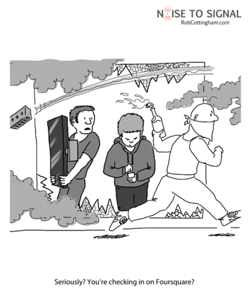Unlike pretty much the rest of Vancouver, I don’t watch hockey — even Stanley Cup finals — so I was in a state of media blackout during the seventh game on June 15. The one exception was Twitter, which I was mostly ignoring because the feed had degenerated into nothing but anguished variations on “AAAAAAAAAAAAAAUUUUGH!!!!! #canucks”.

But by the time the game was due to end, I thought it might be safe to start peeking again. And that’s when I started to see the ensuing riot unfold in ASCII: A car overturned. Then another. Then one on fire. Then windows being broken. And then all hell breaking loose.
Vancouver’s been through this before — the last time we lost a Stanley Cup final, in fact. (That riot was smaller, but the injuries then were more serious.) But one key difference this time, 17 years later, was the ubiquity of mobile devices, connected to the social web.
So not only were people live-tweeting from the scene (including some harrowing feeds from reporters in the crowd), but they were shooting photos and video. The police won’t have to slap down a warrant to pick up that footage, as they did in 1994 when the people with the cameras were TV crews. Instead, clips and snapshots from ordinary people are flooding into Vancouver Police Department headquarters… heavily enough to crash their server, at one point.
But people aren’t just sending their content in privately. They’re also posting it to YouTube, Flickr and Facebook — and in some cases, tagging the faces of the people in the shots. In fact, dedicated pages and Tumblr sites were already up and running before the last of the flames were doused on Wednesday night. About an hour or two into the riot, I was seeing calls on Twitter for people to post, identify and, sometimes, publicly shame those involved… or fire them.
All of that has raised the question of whether we’ve crossed a line between an involved citizenry and what my wife Alexandra Samuel calls citizen surveillance. (She has no issue with the police soliciting photos and videos from the public; her concern is once it goes networked, social and large-scale — not to mention public.)
Alex wrote a post in the Harvard Business Review and a follow-up on her own blog that have sparked a lively conversation: What’s the difference between individuals sending police raw information and networks of people publicly identifying possible miscreants? And is there a meaningful distinction between using social media to turn a spotlight on abuses by those in power, and using it to identify (and publicly shame) individuals?











